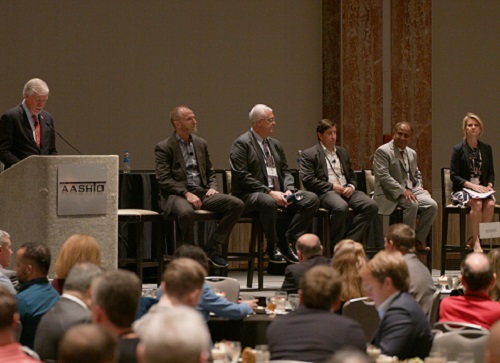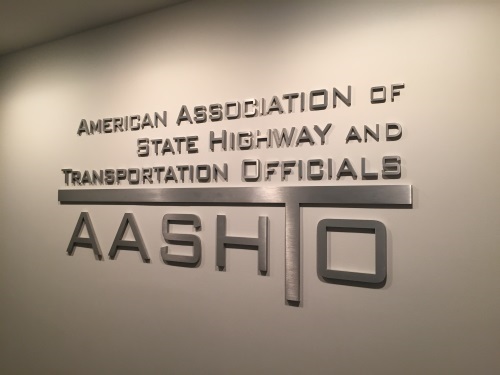At the 2023 Safety Summit hosted by the American Association of State Highway and Transportation Officials, key federal modal agency officials discussed ways to reduce roadway fatalities and injuries to zero.
[Above photo by AASHTO]
“A strong partnership between states and federal agencies is more important than ever to achieve zero fatalities,” noted Roger Millar, secretary of the Washington State Department of Transportation and AASHTO president, during the summit’s luncheon discussion event on October 17.
“One of my priorities with this summit is to engage with all the federal modal agencies and their safety operations,” he explained. “That will help them strengthen their partnerships with state DOTs to achieve greater safety engagement. Because the crisis on our roads is too big for any one federal agency or state government to handle alone – the only way to succeed is by working together.

Sophie Shulman, deputy administrator for the National Highway Traffic Safety Administration, stressed that the “Safe System Approach” being adopted and promoted by the U.S. Department of Transportation is the key to making the federal-state partnership to improve roadway safety succeed.
“Teamwork makes all the difference in improving roadway safety – and the safe system approach is all about breaking down silos and working across modal disciplines,” she explained. “We need a collective effort to reduce fatalities and we need to look closely at the interdisciplinary nature of safety. It’s all about working together and not alone, for compartmentalized plans are less effective.”
Shulman said NHTSA is primarily focused on three critical areas: safer people, safer vehicles, and safer infrastructure. “And rural [roadway] infrastructure is a key focus as half of [rural roadway] fatalities are unbuckled and half are killed in roadway departures,” she pointed out. “The goal is safety and every office – federal, state, and local – has a role to play. Changing the way of planning leads to changes in practice – and that will create more chances to prevent crashes and reduce crash severity.”

Karl Alexy, chief safety officer for the Federal Railroad Administration, said that mindset applies to the nation’s railroad network as well – especially where that network intersects with roadways at rail-grade crossings. “To my mind, given that we are trying to develop rail the way we are now in U.S., a safe rail system is critical,” he said. “You can have all the funding you want, but it won’t move people or freight if the system is not safe. That’s why we are so focused on improving the railroad safety culture.”
Joseph DeLorenzo, associate administrator for safety for the Federal Transit Administration, said his agency is viewing the safety issues through several different lenses.
“First we’re taking a closer look at rider and worker safety – looking at making [transit] systems free from crime, free from assault,” he explained. “This goes back to before COVID regarding an increase in assaults on transit workers and riders. How does this crime prevention piece fit in with our normal safety practices? That is one area we are working on.”
FTA is also looking to enhance broader transit safety efforts in partnership with state DOTs by examining a different set of questions, DeLorenzo said: “Where do transit systems intersect with what a state DOT does? Do transit systems stop in well-lit areas with safe crosswalks? We also need to think of how transit vehicles interact with roadways – what are the impact of roadway changes on buses? How will light rail and pedestrian traffic more safely interact?”
Darrell Ruban, associate administrator for safety at the Federal Motor Carrier Safety Administration, said his agency is engaged in several efforts to help reduce roadway crashes. “We are looking at the root causes of crashes through more data collection and the use of research dollars,” he said. “There are too many crashes and we know we can do more. We have to go above and beyond what we do in this particular area.”
He added that FMCSA is also focused on where technology can play a role in helping reduce crashes and the severity of those that occur as well, such as lane departure warning, anti-collision technology, and automated driving systems.
“We also need to share the information we have not just with the [trucking] industry we regulate, but with the general motoring public to help prevent crashes,” Ruban added. “We need to find a better way of sharing information and data. We also need to recognize that while traffic levels returned to normal after the pandemic, driver behaviors did not. How do we change that? We also need to look at where freight is growing as a sign of economic growth and what that [growth] does from a safety perspective, because [roadway] work zones are a big problem for commercial vehicles.”
Nanda Srinivasan, NHTSA’s associate administrator for research and program development, emphasized the important role better data collection and analysis will play in the effort to reduce roadway fatalities and injuries.
“Data is a big deal because it will help us better design [transportation] systems for people,” he said. “Impaired driving, distracted driving, and speeding all impact design. So we must ask ourselves: Is there something new that we can do? Because planning is the first line of defense where vehicle crashes are concerned, while EMS [emergency medical services] are the last line of defense.”
Cheryl Walker, associate administrator for safety at the Federal Highway Administration, added that while safety has always been a key transportation priority, she feels the industry is “seeing it at a new level” now. “This summit speaks volumes about the importance of [roadway] safety right now,” Walker pointed out.
“People are looking to us and to the decisions we make. So with every decision we make, safety needs to be in there; in everything we do. We all play a role and we all can save lives – so don’t discount ideas,” she said. “We need to ask every [transportation] stakeholder; what can we do differently? Not just are we doing enough, but what can we do more of or differently? We all learn from one another so these discussions can spark an idea for someone else to take an action that could save lives.”
 Top Stories
Top Stories


